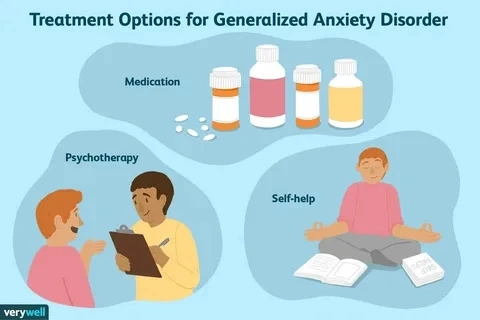For the treatment of anxiety and related disorders, dialectical behavior therapy, or DBT, has proven to be a very successful therapeutic strategy. DBT is based on the concepts of emotion regulation, mindfulness, distress tolerance, and interpersonal effectiveness. It provides a wide range of techniques and abilities to help people manage their anxiety symptoms, lessen their emotional distress, and improve their general well-being. In this thorough examination, we go into the fundamentals of DBT, how it\'s used to treat anxiety, important methods, and how it can change the lives of those who are seeking anxiety relief.
Recognizing Anxiety Disorders and the Difficulties of Treatment
The Intricacy of Anxiety Conditions
Excessive worry, fear, avoidance behaviors, and physiological arousal in response to perceived threats or stressors are characteristics of a wide range of conditions collectively referred to as anxiety disorders. The common manifestations of generalized anxiety disorder (GAD), social anxiety, panic disorder, and specific phobias can seriously impair day-to-day functioning and quality of life.
Treatment Obstacles and Diverse Methods
Treatment for anxiety disorders typically entails a multimodal approach that takes into account behavioral, emotional, cognitive, and interpersonal aspects. While traditional talk therapies and medication are important components of anxiety treatment, incorporating evidence-based modalities such as DBT provides long-term symptom management strategies and comprehensive skill building.
Dr. Marsha M. Linehan, a psychologist, created DBT first to treat people with borderline personality disorder (BPD), a condition marked by extreme emotional dysregulation and impulsivity. DBT has been extensively used as a result of its recognition and efficacy in treating a variety of emotional and behavioral issues, including anxiety disorders.
DBT Mindfulness\'s Core Principles include practicing present-moment awareness, accepting experiences without passing judgment, and paying close attention to thoughts, feelings, and sensations.
Emotion Regulation:
Reducing emotional reactivity and vulnerability by learning how to recognize, categorize, comprehend, and modulate strong emotions.
Interpersonal effectiveness is the ability to negotiate relationships and social interactions by developing assertiveness, boundary-setting, communication, and conflict-resolution techniques.
Distress Tolerance:
Developing the resilience and coping mechanisms necessary to accept and control upsetting circumstances, feelings, and cravings without acting destructively.
Using DBT to Treat Anxiety and Address Emotional Dysregulation
Dysregulated emotional reactions to perceived dangers or stressors are common in anxiety. DBT gives people the tools they need to recognize their triggers, control strong emotions like fear, worry, and panic, and react adaptively—as opposed to reactively—in situations that make them anxious.
Behavioral Reorganization and Awareness
Cognitive restructuring techniques are incorporated into DBT in order to confront and refute anxious thoughts, beliefs, and cognitive distortions. Mindfulness practices foster a grounded, present-focused mindset, increase awareness of anxious patterns, and encourage nonjudgmental observation of thoughts and emotions.
Developing Coping Capabilities
DBT places a strong emphasis on useful coping mechanisms for managing anxiety, such as progressive muscle relaxation, deep breathing, and other relaxation techniques; distress tolerance strategies; self-soothing activities; and efficient problem-solving techniques for dealing with anxiety challenges and triggers.
Strengthening Human Connections
Communication styles, self-esteem, and social interactions can all be impacted by anxiety disorders. With the help of the interpersonal effectiveness modules in DBT, anxiety-causing interpersonal stressors can be lessened by developing healthy relationships, assertive communication, boundary-setting, and need-expression skills.
Essential Elements and Methods of DBT Dialectical Thought
Dialectical thinking, which strikes a balance between acceptance and change-oriented tactics, is promoted by DBT. Along with working toward behavioral adjustments and skill acquisition to enhance anxiety management and general well-being, people learn to recognize and accept the experiences and emotions they are currently experiencing.
Modules for Skill Development
Four modules are commonly included in DBT skills training: emotion regulation, distress tolerance, mindfulness, and interpersonal effectiveness. With the assistance of peer support and individual therapy sessions, participants participate in structured sessions to learn, practice, and apply these skills in their everyday lives.
Chain analysis and behavioral analysis
The sequence of events, thoughts, feelings, and behaviors that lead to anxiety episodes are understood by DBT therapists through the use of behavioral analysis and chain analysis techniques. Customizing interventions and creating individualized coping strategies are made easier by recognizing triggers, vulnerabilities, and maintaining factors.
Diary Pages and Tracking of Skills
Diary cards are a common tool used by DBT participants to monitor their daily mood swings, symptom severity, skill use, and progress toward their treatment objectives. Reviewing diary cards on a regular basis with therapists helps with feedback, skill reinforcement, and necessary modifications to treatment plans.
Efficiency as well as Compatibility with Other Therapies
Studies and Medical Documentation
The efficacy of DBT in lowering anxiety symptoms, promoting overall psychological well-being across a range of populations and anxiety disorders, and strengthening emotion regulation and interpersonal functioning has been demonstrated by a plethora of research studies and clinical trials.
Combining Pharmacotherapy with Additional Therapies
To create a comprehensive and customized treatment plan that addresses each patient\'s needs and preferences, DBT can be combined with medication, other psychotherapy modalities (such as Cognitive-Behavioral Therapy, Acceptance and Commitment Therapy), and holistic interventions (such as mindfulness exercises and lifestyle modifications).
In conclusion, fostering resilience and change
Dialectical Behavior Therapy (DBT) is a cutting-edge method for treating anxiety that provides a wealth of knowledge, understanding, and techniques to help people on their path to emotional control, resilience, and overall wellbeing. Through the treatment of fundamental aspects of anxiety, including emotional dysregulation, cognitive patterns, interpersonal difficulties, and distress tolerance, Dialectical Behavior Therapy (DBT) endows people with enduring abilities to manage anxiety-related challenges and promote constructive transformation in their lives.
Your keyword "Anxiety Treatment" has been incorporated into this article purposefully to keep it relevant to the discussion of dialectical behavior therapy (DBT) and how it is used to treat anxiety. Every section delves into various facets of DBT principles, techniques, efficacy, and integration with other therapeutic modalities. The focus is on the comprehensive approach that DBT provides in enabling people to effectively manage their anxiety symptoms and improve their mental health in general.



